Compared to other popular piano method books on the market, Wunderkeys is the newcomer. Started in 2013 by author Andrea Dow, these books are gaining popularity and shining in a world of outdated methodology.

Recently, I published blog posts reviewing a couple of the top selling piano method book series on the market today: Faber Piano Adventures and Alfred’s Premier Piano Course. One is the flagship piano method series of the largest music publisher in the world, Hal Leonard, and the other the flagship course of the second largest music publisher, Alfred Publishing.
So can the newcomer, published independently through Amazon with a whole different approach to teaching piano, really stand on its own in the competitive world of piano pedagogy? Let’s find out!
As a veteran piano teacher of nearly two decades, I’m going to walk you through my personal 10 criteria for comparing piano method books.
By the end of this post, you’ll understand the unique qualities of the Wunderkeys books and if they could find a place in your studio.
Reviewed By Experience
I only review products that I have personally purchased and used with students in my own studio long enough to determine how effective they are and gain insights on their qualities, pros and cons.
I have personally used Wunderkeys books for many years, so I feel confident that I can provide an in-depth review of the series as a whole, and the individual books. That being said, experiences and opinions vary from teacher to teacher, so I encourage you to do your own research.
My 10 Categories For Comparing Piano Method Books
When I first started teaching, I excitedly drove down to my local music store to peruse the shelves for beginner level piano method books for my new students. I was overwhelmed by the choices! As I opened each first level lesson book, I thought, “Well, this looks nice. And this one looks good. And I like this one, too.”
In a sea of choices when it comes to beginner level piano method books, having specific categories in place to think about, score, and compare can make all the difference in choosing the best one for you.
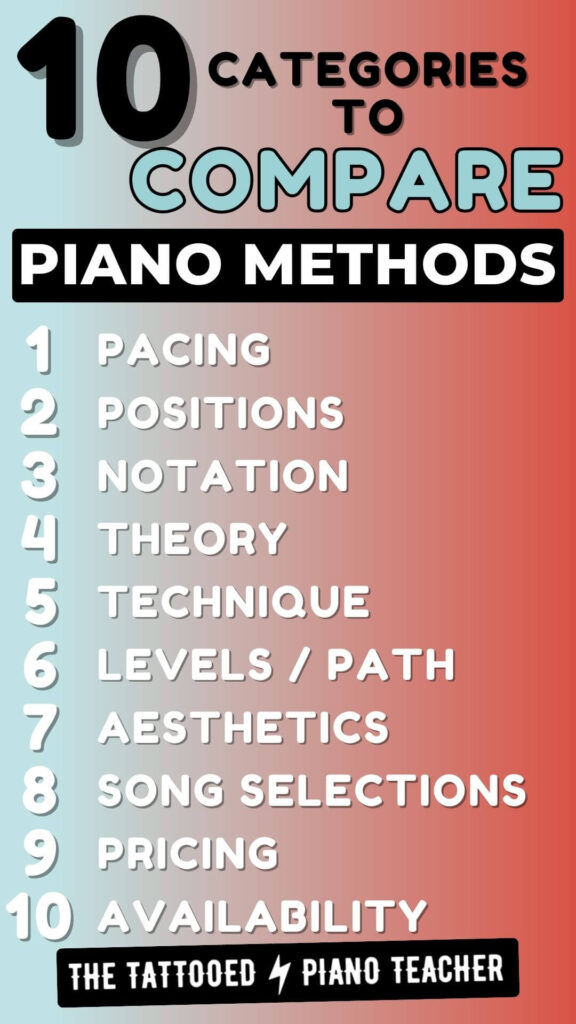
Let me share my categories for comparison and then in the next section, we’ll score the Wunderkeys books in all 10 of these categories.
The categories are:
- Pacing
- Postitions
- Notation
- Theory
- Technique
- Levels/Path
- Aesthetics
- Song Selections
- Pricing
- Availability
For a more in-depth explanation of what each of these categories entails, please check out my blog post Best Piano Method Books For Beginners: My Top 3 Picks where I break down each one in detail.
Wunderkeys: An In-depth Review
Time to dive into the Wunderkeys piano method book series and use the above categories to give us an overhead view of how well this would work for our beginning piano students.
Quick Disclaimer: This post is entirely based on my opinions and personal experience with these books. I understand that other teachers may have a different experience with the books reviewed in this post.
Pacing: Slow Pace
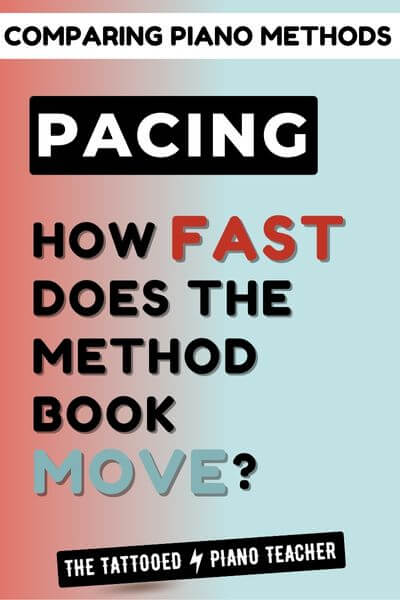
Compared to other piano method books on the market, Wunderkeys Primer series moves slower through the concepts and skills. Faithful fans of the Wunderkeys piano method books claim their students became better note readers when they switched from other methods.
Each new note and new position is carefully introduced and meticulously reviewed until it is forever mastered before moving forward. A student who requires lots of review before fully grasping something new, this series could be just the thing to help them succeed at the piano.
For the right student, the Wunderkeys piano method books can be a wonderful fit that helps them retain and review new skills and concepts.
Positions: Middle C Position for all of Book 1, C Scale for all of Book 2 and Book 3
The Wunderkeys Primer piano method series is unique in that it keeps students in one hand position for long periods of time.
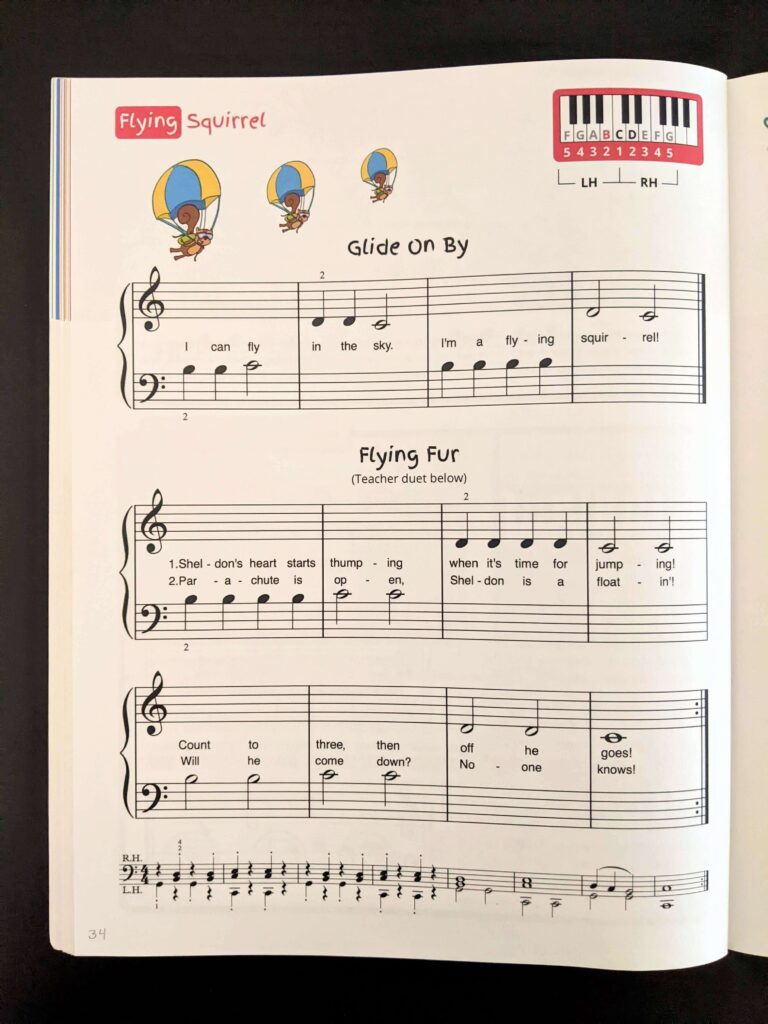
Positions Introduced at Each New Level
(Click any link to shop on Amazon)
In Wunderkeys Primer Book 1, students learn and stay in Middle C Position for the entire book.
In Wunderkeys Primer Book 2, students are introduced to Bass C, D and E and move the left hand down to the C Pentascale. They stay in this position for all of Primer Book 2 and all of Primer Book 3.
It isn’t until Wunderkeys Level 1A that they explore moving the right hand (up to Treble C Pentascale). And in Wunderkeys Level 1B, they are exposed to G Pentascale towards the end of the book.
By the end of the Wunderkeys Intermediate level books, students are playing in any key signature. So the series is certainly not anti-movement on the keys. It just has a different approach to the first years of learning.
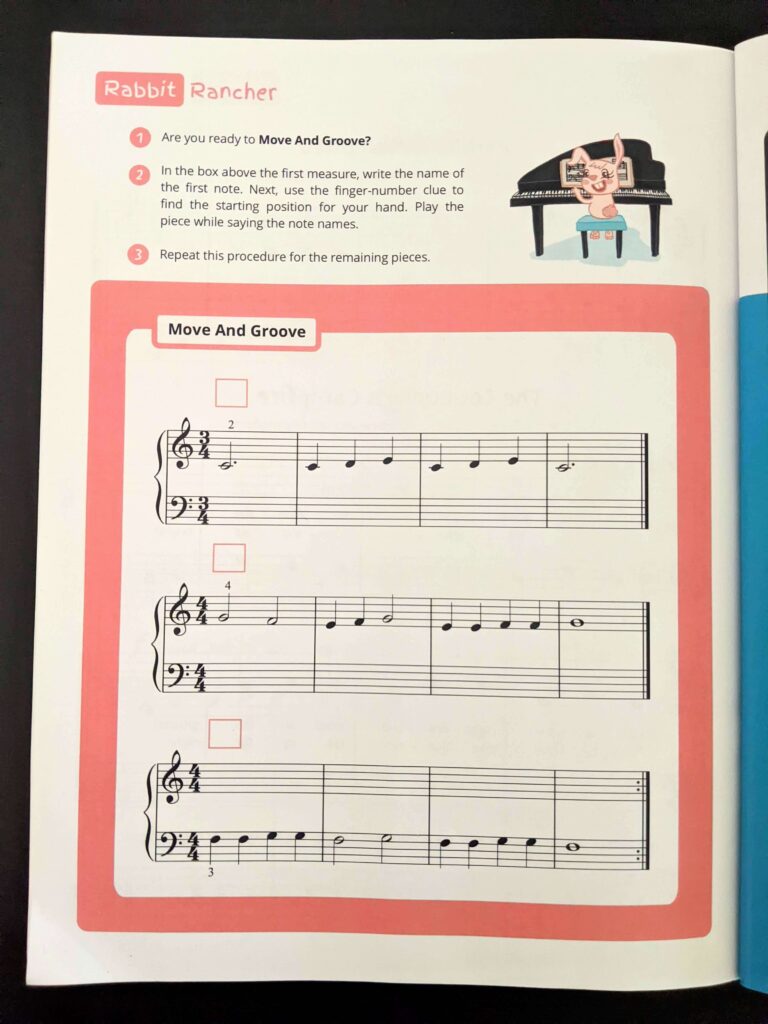
Move and Groove Pages
It’s important to note that what the Primer Level books lack in position diversity within the songs, they make up for with frequent “Move and Groove” pages.
Through the books, students are encouraged to investigate a one-line song and figure out where the hands go and then play it.
These mini-songs are intentionally written to move one hand “out of position” by a step or skip to encourage the ability to play with the fingers on different keys.
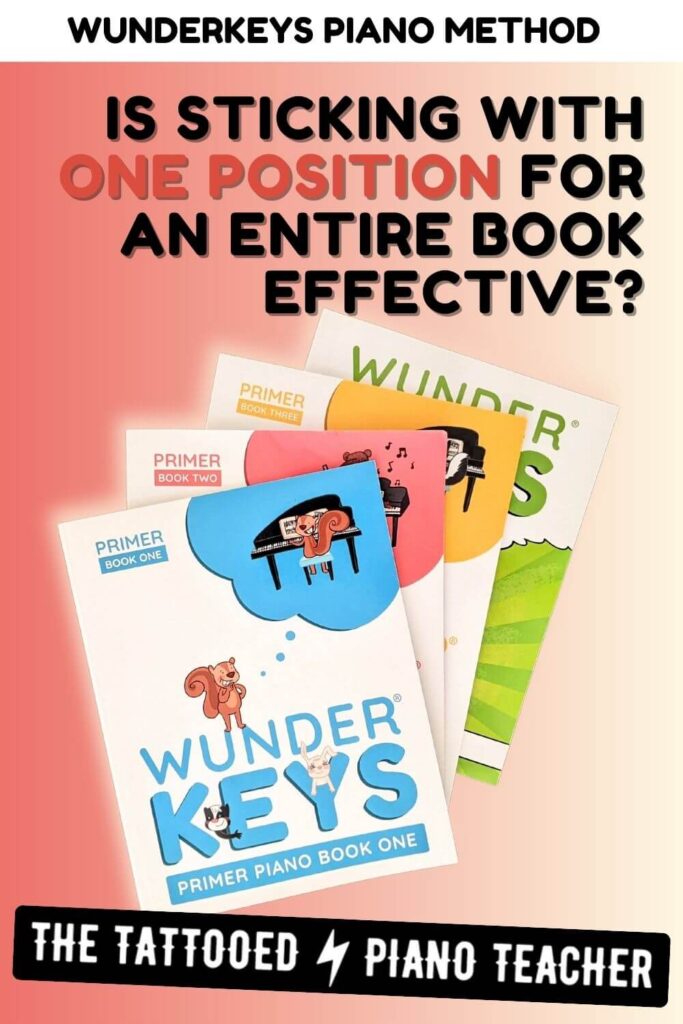
A Different Approach
Many piano teachers feel very strongly one way or the other when it comes to hand positions in beginner piano method books. Some teachers are pro-movement and believe that staying in the same position limits students’ flexibility and note-reading skills in the long run. Other teachers find it easier to keep to one position until the notes are mastered.
I like to take a more moderate approach incorporating both methodologies and not getting stuck on one side. Each student is different and changing it up is best for most students.
Wunderkeys is great for a student who is really thrown off by different positions. If a student is so lost figuring out where to place their hands for each song when practicing at home, they may never hear the songs played with the right notes! Some students are better served staying in one position for a while and building other skills such as note recognition, articulation, technique, dynamics, etc. When they are ready, you’ll know it’s the right time to try introducing alternate hand positions.
Notation: Staff Reading Introduced Halfway Through Book 1
Much like other piano method books, Wunderkeys Primer Book 1 starts with off-staff notation. Reading notes on the staff is introduced halfway through Book 1.
No Guide Notes!
Wunderkeys does take a different approach to reading notes on the staff for beginners. This series focuses intensely on recognition and review of any new notes introduced.

Book 1 also preemptively addresses common mix-ups. For instance, after learning Middle C on the staff, students learn B and D. B and D are commonly mistaken for each other by beginners because they look the same, just mirrored. The book encourages focus on these two notes until they are mastered. Next students are introduced to A and E, also mirror images of each on the bass and treble clefs.
Part of the reason for the slower pace of the Wunderkeys Primer level books is the slow introduction and review of each new note on the staff. The result is slow progress at first, but very good note readers in the end.
Note Introduction Schedule
Here is a list of new notes and positions/scales introduced in each Wunderkeys Level (click any link to shop on Amazon):
- Primer Book 1 – Middle C Position notes starting with Middle and working outward
- Primer Book 2 – C Pentascale, adding Bass C, D, and E
- Primer Book 3 – Reinforces C Pentascale (no new notes or positions introduced)
- Elementary Book 1A – Treble C Pentascale
- Elementary Book 1B – G Pentascale, adding Bass D above Middle C
- Elementary Book 2A – Gm Pentascale, D Pentascale, Dm Pentascale, A Pentascale, Am Pentascale, adding Treble A and B below Middle C, and Bass A and B (lower)
- Elementary Book 2B – C Major, G Major, D Minor
- Intermediate Book 1 – F Major, A Minor, E Minor
- Intermediate Book 2 – D Major, B Minor, B-flat Major, G Minor, A Major, F-sharp Minor
- Intermediate Book 3 – E-flat Major, C Minor, E Major, C-sharp Minor, A-flat Major, F Minor
Theory: No dedicated theory book to go with the series; mini writing assignments in each unit; separate writing workbooks available by the same author
Theory in the Lesson Books
Although there isn’t an official Wunderkeys theory book, short writing assignments and listening games are written into the main book. Each unit includes a couple of very brief identifying or drawing instructions.
Writing Workbooks Available
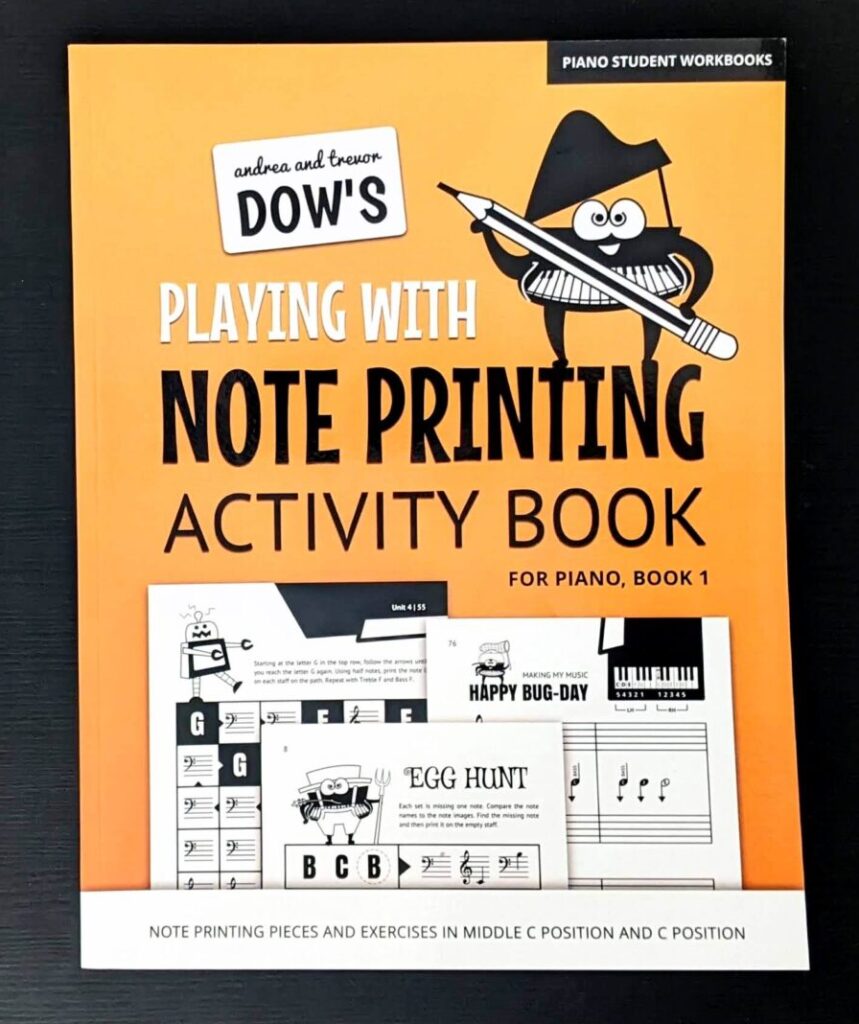
Andrea Dow, the author of the Wunderkeys piano method books, does publish a couple of writing workbooks which could be used as a notespeller or theory book alongside the main lesson book. However, beyond note recognition, there isn’t a lot of theory content in the Wunderkeys series.
Available Workbooks include (click any title to shop on Amazon):
- Playing With Note Printing Activity Book For Piano, Book 1
- Timed Note Reading Tests For Piano, Book 1
- Timed Note Reading Tests For Piano, Book 2
In the Intermediate level Wunderkeys books, keys, scales and chords are shown at the beginning of each unit, but no explicitly clear theory teaching or writing assignments are included.
Free Printables
There are many worksheets and games available on the Wunderkeys website. Sign up with your email and you’ll have access to all the free Wunderkeys resources to download and print. But, besides a few chord or key signature worksheets, there isn’t a lot of advanced theory content beyond note and interval recognition.
Technique: No dedicated technique book to go with the series; mini technique assignments in each unit
The Wunderkeys method is highly unique in its approach. In summary (in my opinion)…
- Wunderkeys Primer Level books focus intensively on note recognition to the detriment of technical skills.
- Wunderkeys Elementary Level 1A and 1B focus fairly equally on note recognition and technical skills.
- Wunderkeys Elementary Level 2A into the Intermediate Pop Studio For Piano books focus intensively on scales, chords and pop/modern piano technique, perhaps to the detriment of theory.
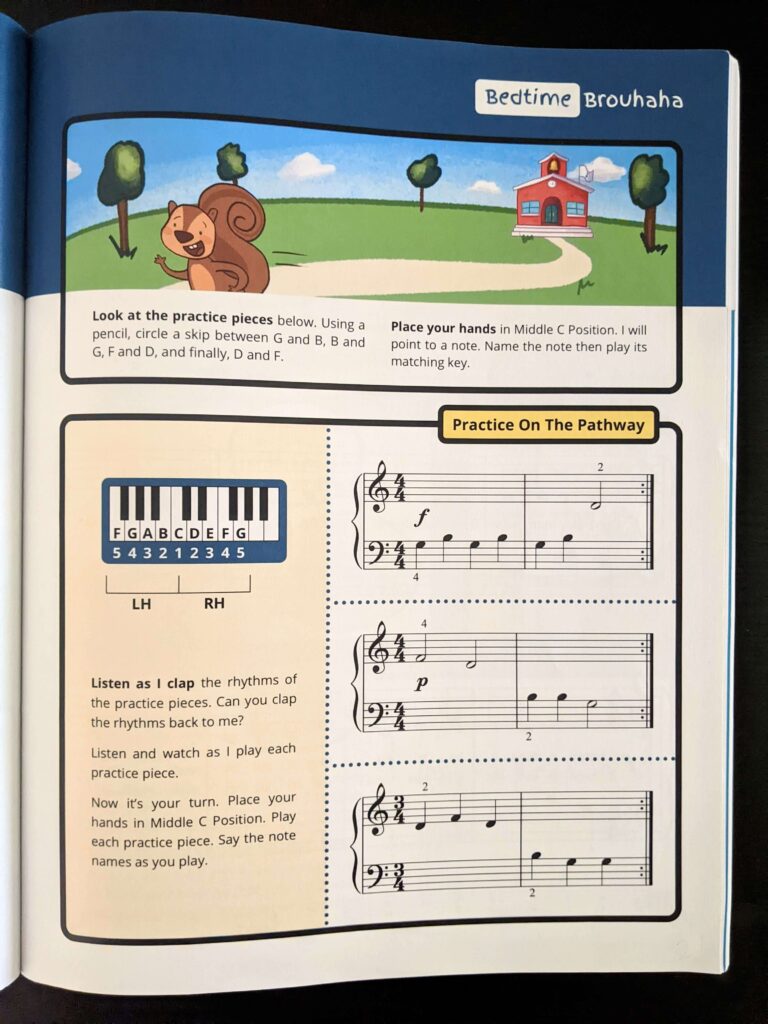
That’s not to say the Wunderkeys Primer Level books do not include any technique. From the very first unit in the first book, there are dedicated “Practice on the Pathway” pages which feature three one-line mini-etudes. If you read the instructions, you will find instructions to include dynamics. However, they definitely feel more like sightreading challenges than skill-building exercises.
The Wunderkeys Elementary Level books include these pages as well in each unit, renamed “Technical Exercises.” In the Elementary Level books, these pages do include staccatos and slurs (and, of course, simple dynamic markings), but still feel more like sightreading exercises than anything else.
There is a shift going into the Wunderkeys Elementary Book 2A and 2B. Scales begin to show up and by the time we get to the Intermediate Pop Studies For Piano, about half of the main lesson book is dedicated to scales, chords and etudes.
I can’t speak for the author, but I tend to think the above timeline is intentional. In many ways, the Wunderkeys piano method books implement a “focus on one thing until it’s mastered and then move on to something new” philosophy.

Levels/Path: 3 Primer Levels, 4 Elementary Levels, 3 Intermediate Levels / Modern
Levels
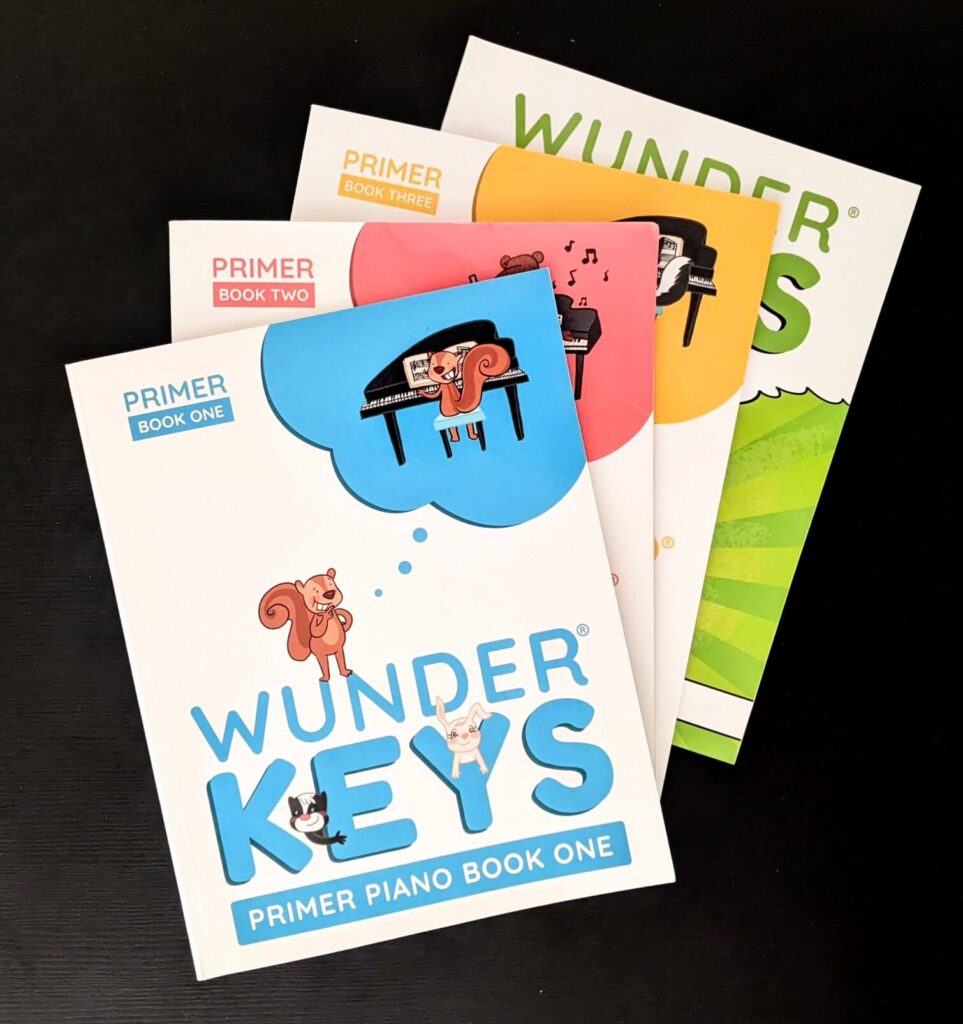
The Wunderkeys piano method series offers the following levels:
- Primer Book 1
- Primer Book 2
- Primer Book 3
- Elementary Piano Book 1A
- Elementary Piano Book 1B
- Elementary Piano Book 2A
- Elementary Piano Book 2B
- Gap in the series*
- Intermediate Pop Studies For Piano 1
- Intermediate Pop Studies For Piano 2
- Intermediate Pop Studies For Piano 3
- Intermediate Pop Studies For Piano 4 (coming soon…hopefully)
Students end the series at an intermediate level.
*Gap in the Series
Upon completing Elementary Piano Book 2B, most students (in my personal experience) will not be ready for Intermediate Pop Studies For Piano 1. To my knowledge, there is not a bridge option published by Wunderkeys. Personally, I take a detour into another series, such as Faber Piano Adventures, and return to the Wunderkeys Intermediate books if it seems a good fit for the student.
Song Flavor
The three books in the Wunderkeys Primer series have very generic songs but, this is common in beginner-level piano method books.
In the first two books of the Wunderkeys Elementary series (Levels 1A and 1B), the songs remain fairly basic. It isn’t really until Level 2A that the true “flavor” of the Wunderkeys literature shines through. We’ll discuss that flavor more in depth in the Song Selections section.
To summarize, by the end of the Intermediate series of books, students will be very well-adept at what I will call modern/new age style of playing. Students will also possess many of the technical skills needed to tackle easier classical literature, but would not have had direct exposure to original classical pieces within the Wunderkeys piano method books.
Aesthetics: Amazing characters; one-of-a-kind comics; silly games
Colorful Page Design
The first time you flip open a Wunderkeys Primer or Elementary level book, you will immediately notice their unique take on keeping kids’ attention. There are no dull pages in a Wunderkeys piano method book! Every page is colorfully designed for a modern and appealing experience designed with kids in mind.
Adorable Characters

The pages of the Wunderkeys Primer books are filled with comics featuring four characters you and your students are sure to fall in love with. Sheldon the Squirrel, Ruby the Rabbit, Gary the Grizzly Bear, and Maxine the Skunk go on silly adventures and show their distinctive personalities through mini-stories in every unit.
I have also purchased the finger puppets depicting these four loveable characters and my students absolutely go crazy for them! They are handmade and so, so cute. And they take the engaging stories one step further by bringing the characters to life. Check out the Wunderkeys-themed finger puppets here.
These four core characters appear only in the Primer Level Wunderkeys books. The Elementary Level books include a rotating cast of other characters (not nearly as memorable). And the Intermediate Level books feature modernized, abstract portraits of famous composers in place of characters and stories.
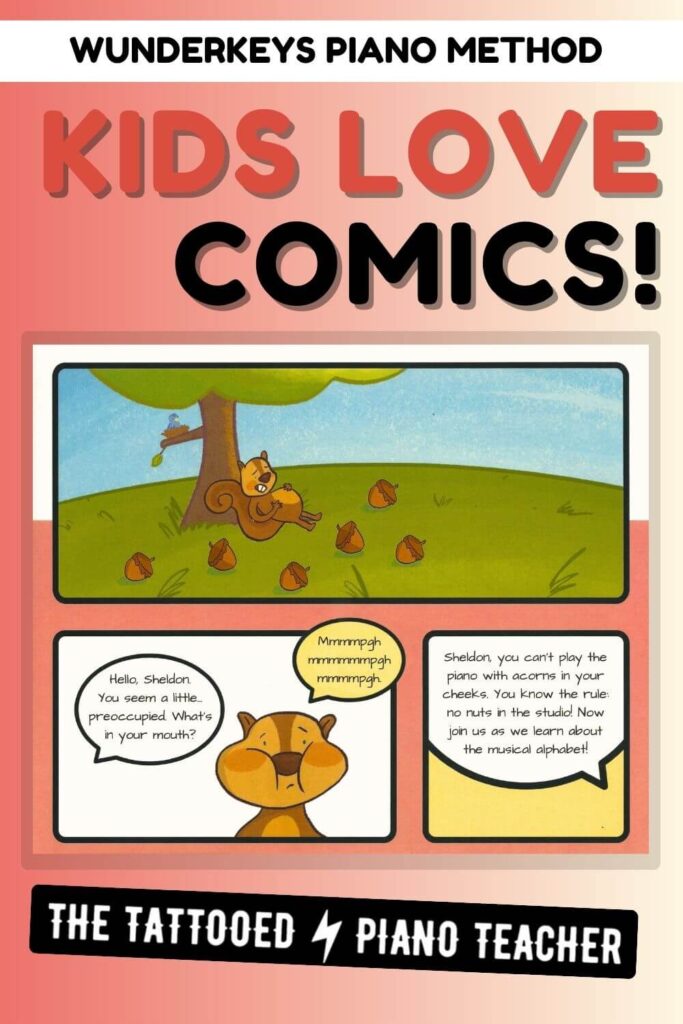
Comics in Every Unit
Although I personally find the comics to be a little shallow and disjointed (loosely relating the characters’ situations to the piano concepts being introduced), the kids love them, and that’s what counts. And, I mean, comics in a piano lesson book…one can’t be too picky.
The Primer and Elementary Level Wunderkeys books feature comics on nearly every page. The Intermediate Level books do not include comics.
Games
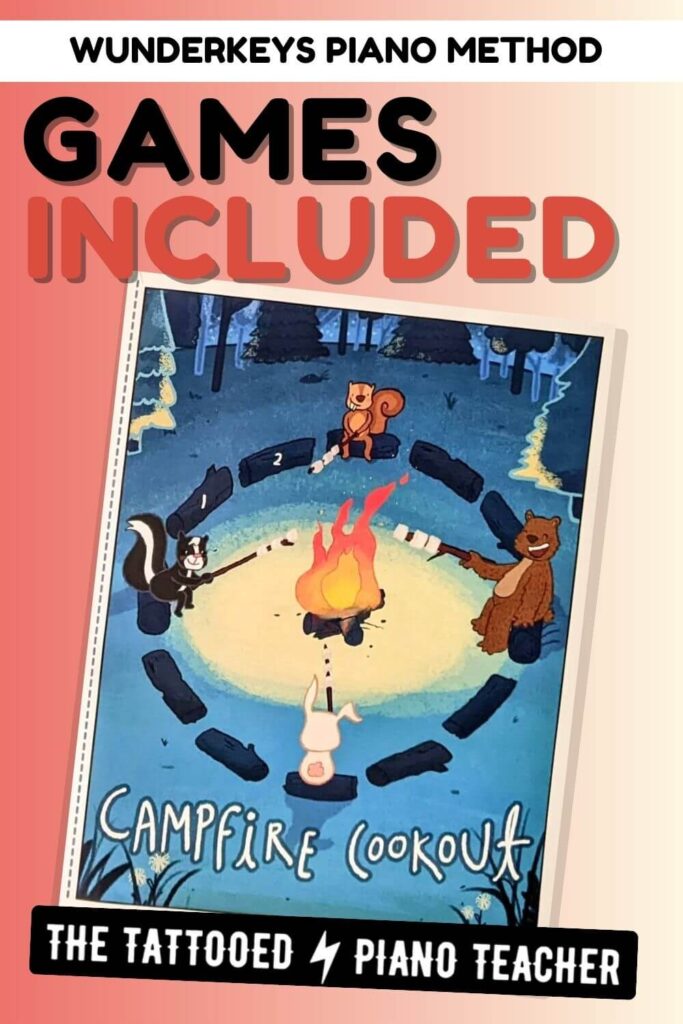
There are also four games included within the pages of every Wunderkeys Primer Book.
The games leave a little to be desired as far as music theory games go. The instructions are sometimes complicated, they require some prep time and game pieces of various sorts, and the music theory concepts are not comprehensively reviewed during gameplay.
However, the game pages feature a bold, beautiful design, and the kids just love the fact that there are games in their book. And again, games in a piano lesson book? Let’s not judge too harshly.
Games are included only in Wunderkeys Primer Book 1-3. No games are included in the Elementary or Intermediate Level books, although some games are available as free printables on Wunderkeys.com.
No Page Numbers
One random note to add: the Wunderkeys Primer Level books do not have page numbers. Elementary and Intermediate Level books do include page numbers.
The lack of page numbers is intentional in the Primer books. Personally, I find it difficult to communicate assignments in these books without page numbers. So I pencil in page numbers myself.
Song Selections: Early level songs leave much to be desired, but kids love the stories and characters so much they hardly notice (Supplemental songs are a little better)
The author of the Wunderkeys piano method books, Andrea Dow, is a good composer with a distinctive style to her compositions. You (or your students) will either be really into it, or not. To get a sense of the style of pieces you’ll be hearing the later Wunderkeys books, check out the sample pages on the Wunderkeys website, or listen to recordings on SoundCloud.
For a student that wants to play music in this style, it might be worth wading through the simple tunes in the Primer and Elementary level books to get to the performance-worthy pieces throughout the Intermediate level books.
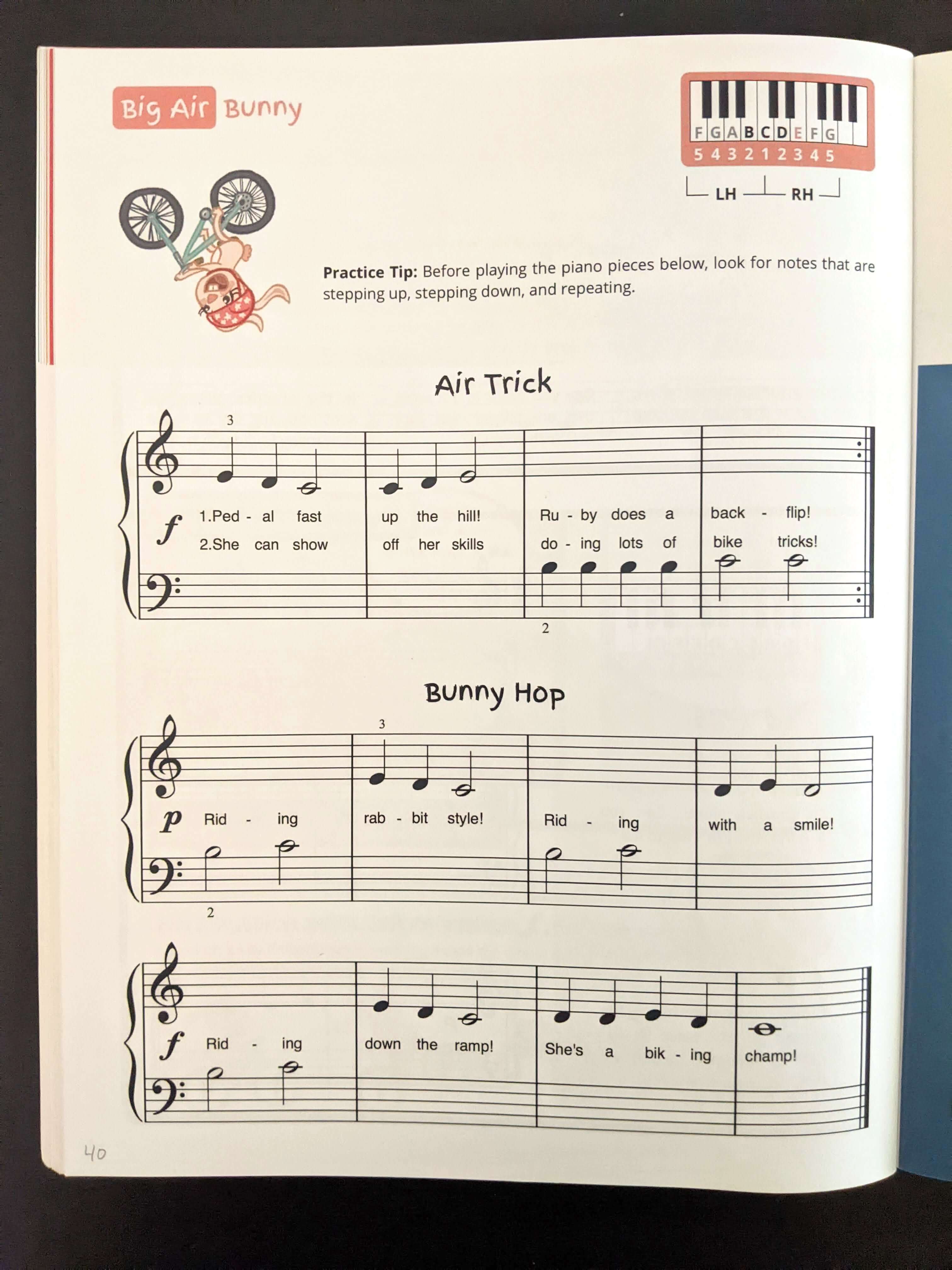
Here’s my personal take on the songs presented throughout all levels of the Wunderkeys piano method book:
Wunderkeys Primer Level Books (Primer Book 1, Primer Book 2, Primer Book 3)
Little to no performance-worthy songs. Songs are very short (4-12 measures), super simple, and don’t really “sound like anything.” Students really cannot tell if they are playing the songs correctly (notes or rhythm) because they are so generic in nature. However, the lyrics are fun and students enjoy singing along.
And I do feel the need to caveat my critique by stating that it is my opinion and you, as a teacher, may love the songs in the Primer books. Also, if they are no show-stoppers but do the job of entertaining the students while fostering note recognition, then perhaps we can look past their simplicity.
Supplementary Books: Wunderkeys Very Useful Piano Library
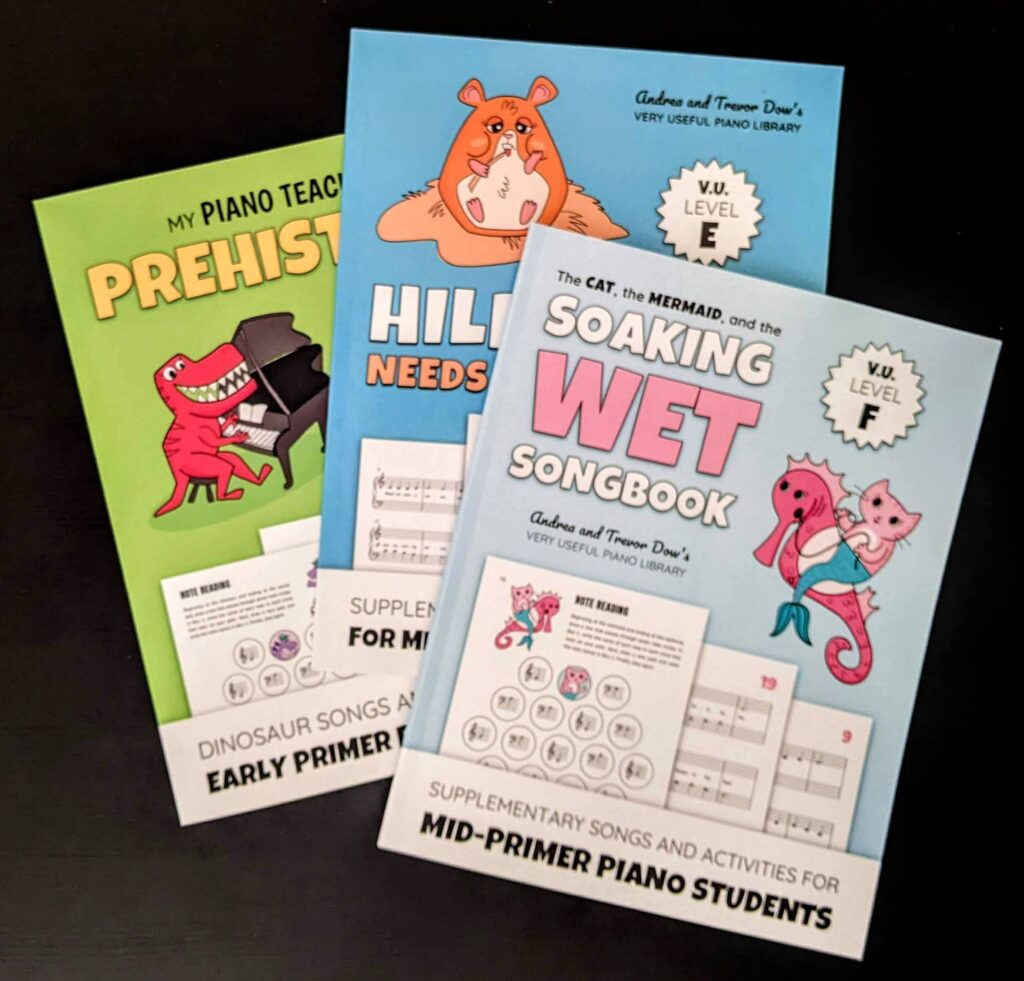
One other important note about the songs presented in the Wunderkeys Primer Level books–Wunderkeys does offer a line of supplementary books at every level with better sounding songs. These supplementary books, known as the Very Useful Piano Library or VUPL, also feature lovable characters and captivating stories. The songs are longer (most two pages) and sound more performance-worthy than the songs in the main lesson books.
Check out the array of Primer Level supplementary books here.
And to read more about how the Wunderkeys supplementary books work, how to incorporate them, and how to choose the correct level for each student…I have an article for that!
Check out my Wunderkeys Supplementary Book Review here.
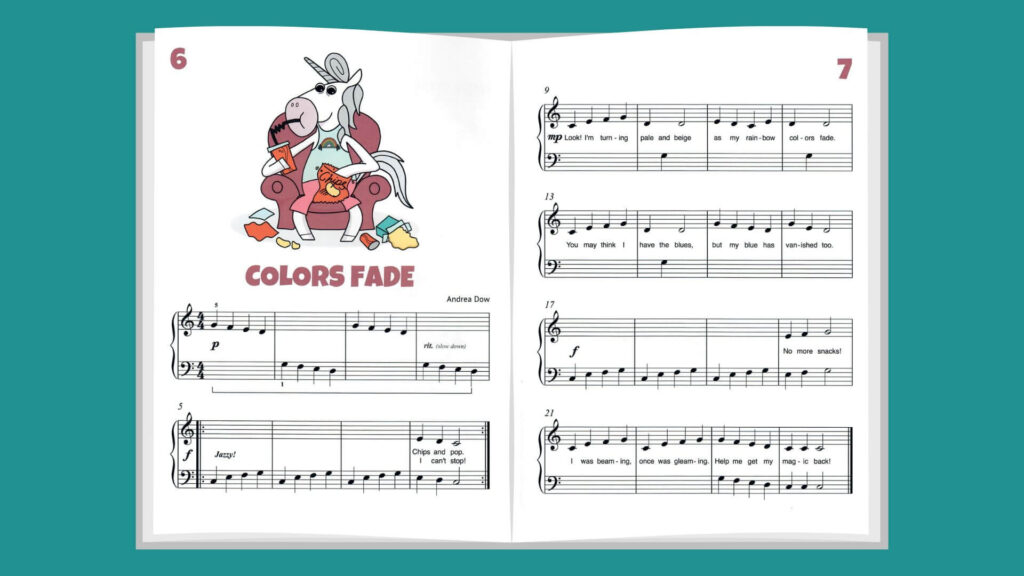
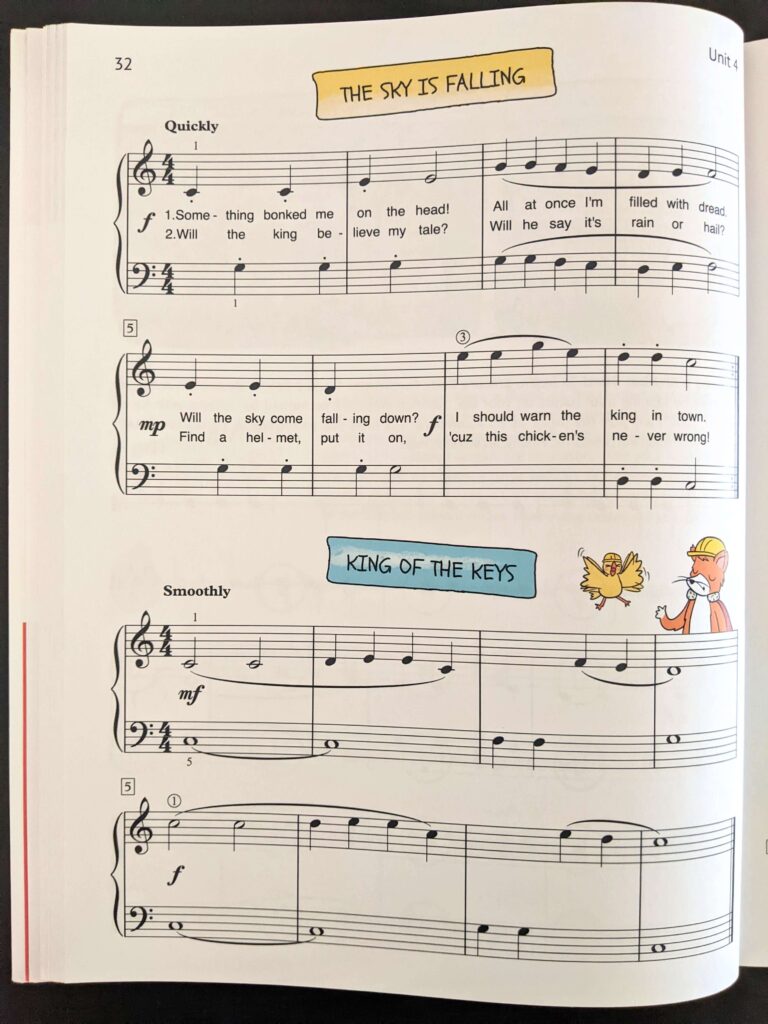
Wunderkeys Elementary Level Books, first two (Elementary Book 1A, 1B)
Mostly generic-sounding songs in the first two books, but they do get longer with some hand shifts mid-song. There are a few “hits” that I might consider including in a recital throughout Book 1A and 1B. Lyrics and titles are still interesting to students.
Wunderkeys Elementary Level Books, second two (Elementary Book 2A, 2B)
In Book 2A and 2B, the songs get more interesting and start to “sound like something.” Students can now “get the flow” of most of the songs and can tell whether they are playing it correctly. Once minor is introduced (with sharps and flats), the songs flow better.
By Book 2B, Andrea’s Dow’s composing style shines through. There are performance-worthy selections in Book 2B, for sure.
Wunderkeys Intermediate Pop Studies For Piano Books (Book 1, Book 2, Book 3)
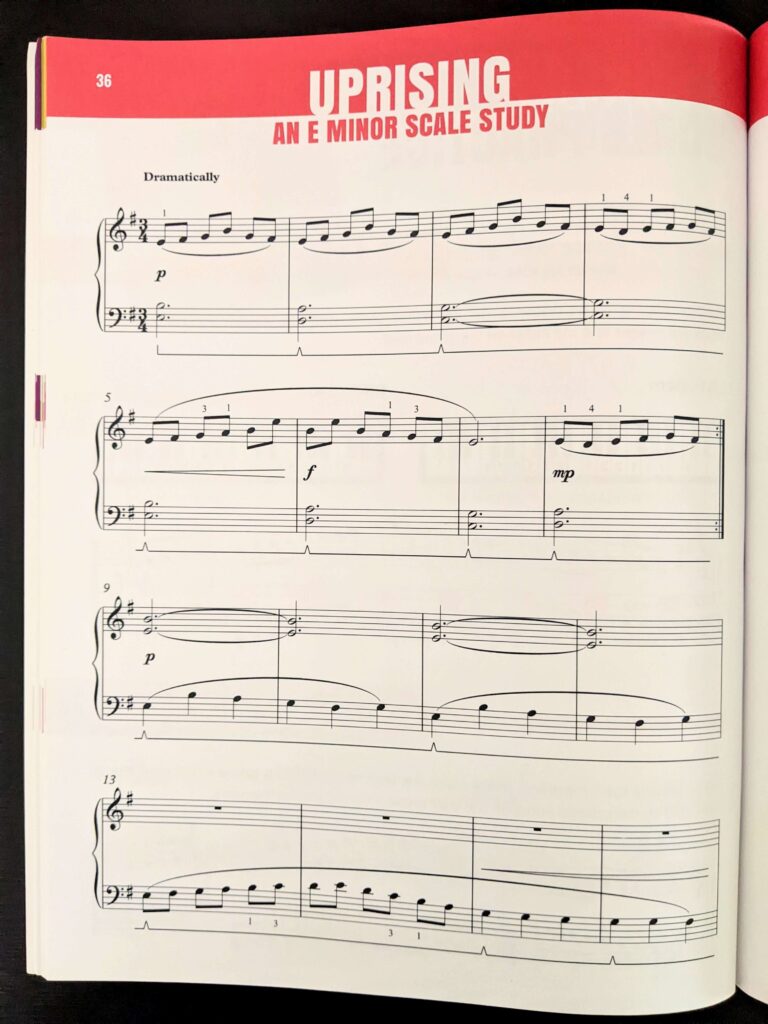
The title of these books is a bit of a giveaway, but in the pages of the Intermediate Wunderkeys books you’ll find Dow’s signature sound in every piece. I would describe the genre as Celtic-inspired, modern piano.
The chord progressions live up to the books’ title, sticking mostly to I, IV, V, and vi chords. While the chord structure of these pieces is predictable, these pieces are impressive to listen to and fun to play.
If your student loves this style of piano music, they will thrive in these books. However, be cautious of the one-sidedness of these books and supplement with other literature as needed.
Pricing
Wunderkeys has a slightly higher per-book price than other piano method books. However, the Wunderkeys books are intended to, for the most part, serve as an all-in-one lesson book. This means that instead of purchasing the Piano Adventures or Premier Piano Course four core books as a set, you could purchase just the Wunderkeys book for around $15 and perhaps just one or two supplementary books.
Lesson + Supplemental Books
A suggested set of starter books:
- Lesson Book (main book) – Check price on Amazon
- Student Workbook – Check price on Amazon
- Supplementary Book – Check price on Amazon
Availability: 7/10
For better or worse, Wunderkeys piano method books are only available on Amazon.com.
- You will not find them sold directly on the Wunderkeys website
- You will not find them sold on SheetMusicPlus.com
- You will not find them sold on EveryMusicBook.com
- You will not find them sold at your local music store
- You will only find them sold on Amazon
For this reason, I’ve rated the availability of Wunderkeys books at a 7 out of 10. If you love Amazon, you’re in luck! If you are not a fan of Amazon or like to scope out seasonal sales, sorry, my friend. Although Amazon occasionally discounts some of the Wunderkeys books, the only place they are available is through Amazon.
Do I Recommend Wunderkeys For Beginners?
In my own studio, I keep a variety of Wunderkeys books on the shelf ready for students of all ages. It is not my most-used piano method series in the studio (that would be Faber Piano Adventures), but it has become a go-to pick in certain situations.
Here are some scenarios where I love to use the Wunderkeys books in my studio:

New Students Age 4-7
If I have a new piano student between the ages of 4-7. This age is the sweet-spot for fully appreciating all that the Wunderkeys Primer Level books have to offer.
Finger puppets, cute comics, and games?! What kindergartner or first-grader wouldn’t eat that up?
And the slower pace is no problem with this age group. They need extra patience and review to retain the language of music anyways, so why not truly embrace the slow path?
Needs Extra Help With Notes
I have a first- or second-year student who is struggling with note recognition.
Let’s say I start an 8-year-old in the Faber Piano Adventures Primer Level and they are doing great until we hit those lower bass clef notes (Bass C, D, and E seems to be where some get stuck). We struggle through the songs, but they are visually frustrated by these new notes, and they are now forgetting the notes they learned earlier (such as A and B below Middle C).
As a perceptive teacher, I know we need a time-out from this method book to step back and review and re-introduce.
In come the Wunderkeys Primer Books to the rescue!
Losing Interest
A student who is quickly losing interest in their current method.
They are a kid with a big imagination who love to tell stories and chit-chat during lessons. They seem to only enjoy the select song here and there that captures their attention. They might be a good fit for Wunderkeys!
If you feel them slipping away and practicing less, the cool comics, stories and games in the Wunderkeys books may be just what the doctor ordered to re-inspire them.
Partner & Group Lessons
I love Wunderkeys for partner and group lessons.
The all-in-one nature and simple layout of these books makes them incredibly ideal for teaching multiple students at a time.
Plus, the characters, lyrics, stories and games are an instant unifying force amongst young people. They love comparing their favorite characters and reading the comics together.
Wunderkeys paired with partner or group lessons has been a big win in my studio in the last few years!
Conclusion
I definitely think Wunderkeys is worth checking out.
Let me know in the comments: Have you heard of Wunderkeys before? Would you try it? Have you tried it? I want to hear from you!
What Other Piano Method Books Would You Recommend?
Still want to browse for other options? I get it! I like to shop around before making a decision too.
Check out my blog post: Best Piano Method Books For Beginners: My Top 3 Picks.

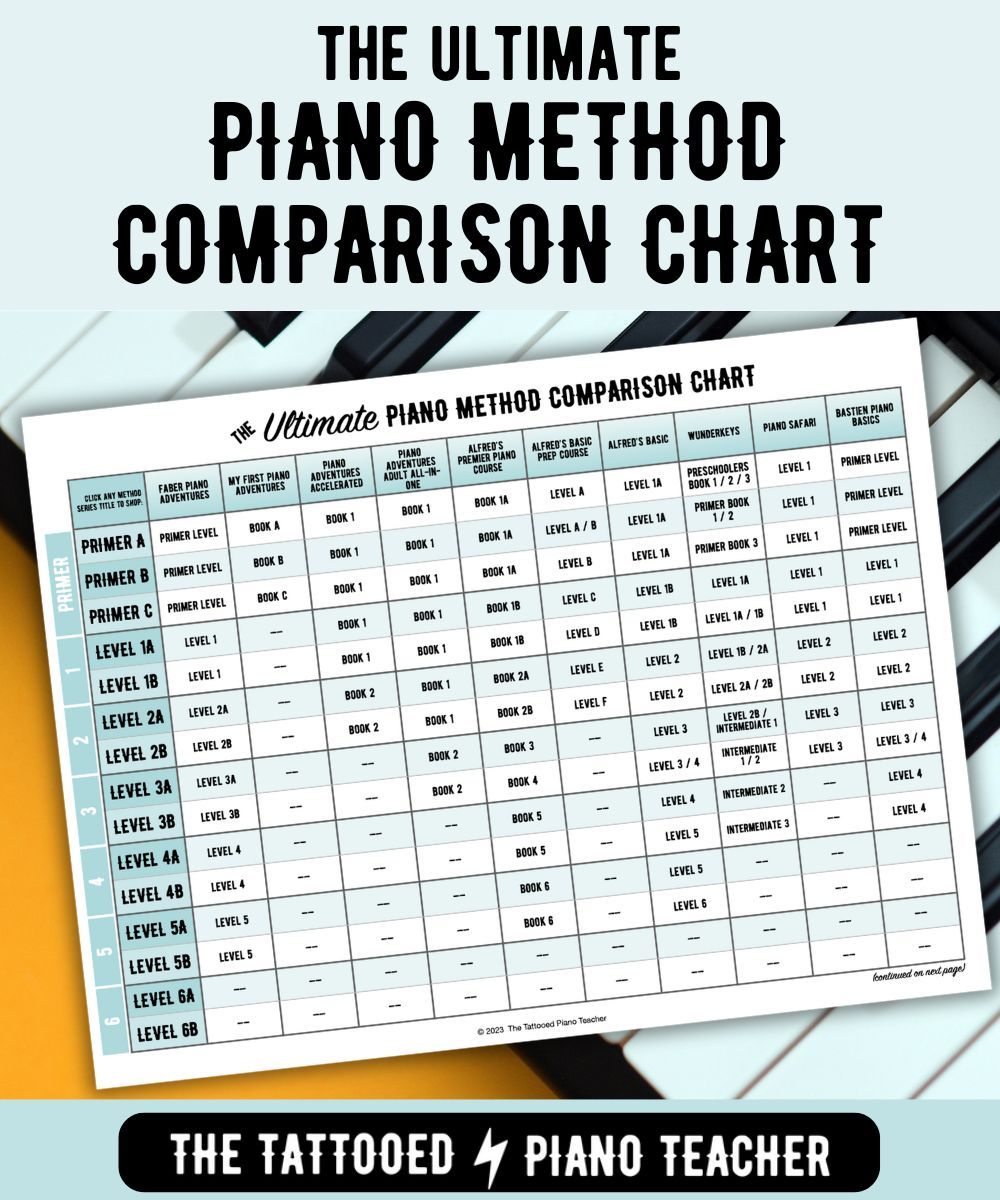
9 Responses
I’ve been using the Wunderkeys books for a while now.
I agree that the primer books are well suited for the younger beginner 5 – 6+. (Do you realise there are preschool books too?) How ever from age 7, or of you have a really bright student, they do move a bit too slow so I use something else. From comments on the FB support page, the suggestion is to move through the books faster for this group. This only works if the student is motivated and works through the book themselves at home, you can the skip pages in the lesson if they have done these pages correctly. You might be able to cover a couple of units in a lesson if you have long enough lessons though. Yes the pieces can become tedious but, if you belong to the Piano Book Club, there are books that have longer tunes and sometimes well known tunes often with a ‘joke’ included. The adult get it but students won’t if they haven’t been exposed to those songs in their preschool years.
Another thing that I like with the Wunderkeys books is that they ‘grow up’ with the child the pictures and stories change to ‘suit’ the expected age the child will be in that level of book.
The Very Useful library of books go into micro levels if a student is struggling with a concept/technique to give them more exposure/practice with those concepts/techniques.
Wundekeys have an older beginner set of books now too. At present levels 1 to 3. 4 is still to come to complete the set. After 4 you go into the Intermediate books but, at the moment you need to go into the level 2 book after book 3.
Depending on the student, the Older Beginner book can be used from age 9 or 10 but definitely for teens and adults. I add extra pieces into the 1st unit of the OB book 1 as that unit is almost all technical/concept learning and most like to be able to play a tune from the 1st lesson.
I find there’s a gap for the 7 to 9 year olds – the primer is too young but they are not ready for the OB book.
Hi, thanks for sharing your experience! It’s great to hear from someone who has really used the Wunderkeys books to their fullest potential. Thanks for your input!